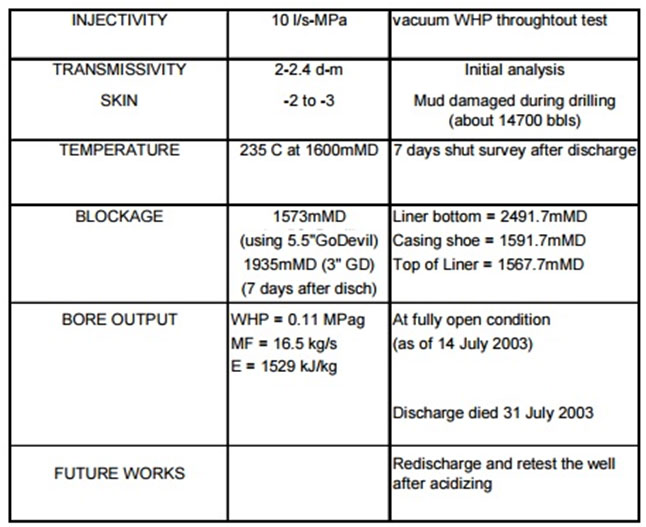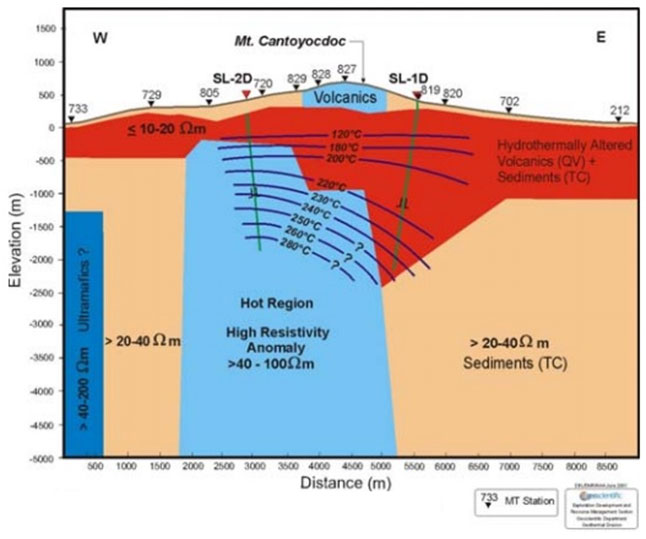Pure Energy Holdings Corp. (PEHC) was established in 2013 to gain a foothold in the booming energy and utility sectors in the country. It is an investment holding company whose purpose is to strategically acquire assets, develop natural resources that are sustainable, and be a basic service provider for the needs of the community.
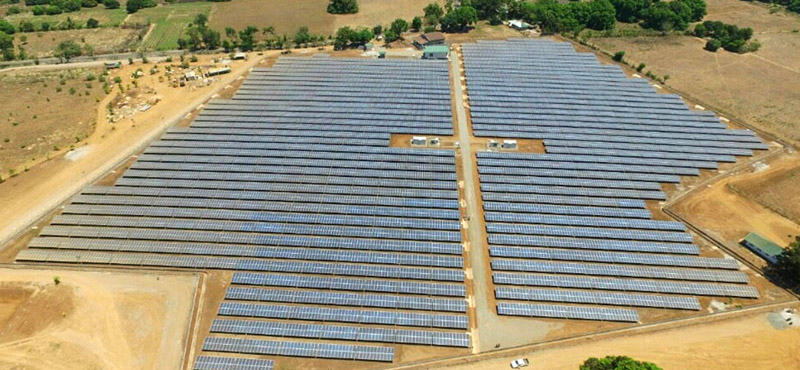
PEHC, through its subsidiaries, Just Solar Corp, Repower Energy Development Corporation, and Pure Geothermal Inc., harnesses and develops indigenous natural resources in niche areas and converts it to energy - renewable energy from which the surrounding communities directly benefits. Renewable energy that is clean, sustainable, environment-friendly, and comes at a low cost. The company has grown through strategic acquisition of high-potential, existing solar and hydropower generation plants along with systematic maximization of their value through operational improvements, focused redevelopment, and introduction of new European technology. We have pioneered the clustered approach to our projects to achieve economies of scale in their construction and maximizing economic potential.
PEHC, through its subsidiary, Tubig Pilipinas Group Inc., is a bulk water supply and water distribution company with operations around the country. TPGI has a coverage spanning Luzon, Visayas, and Mindanao. The company is continuously expanding its concession footprint in the different regions and provinces in the country and is an up and coming major player in the water business.
We, Pure Energy Holdings Corporation, have a unique ability to quickly recognize and test attractive opportunities and solve issues by acting decisively in implementing solutions. PEHC acquires the knowledge necessary to develop the best strategies and solutions for solving complex operational issues and exploiting new development opportunities. We have the operational expertise, experienced World Bank consultants, and in house capabilities to efficiently execute our own plans in a safe and environmentally responsible manner. As our subsidiaries' operations have increased through continued acquisitions and organic growth, PEHC has consistently developed the skills and experience required for continually replicating success. PEHC is also testing new and innovative forms of energy production.
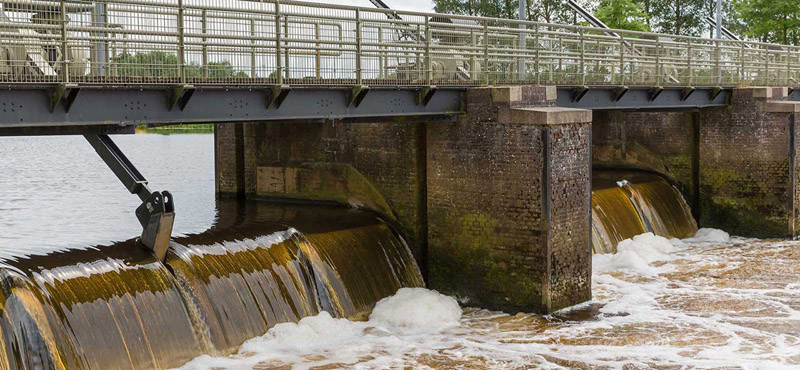
Organization
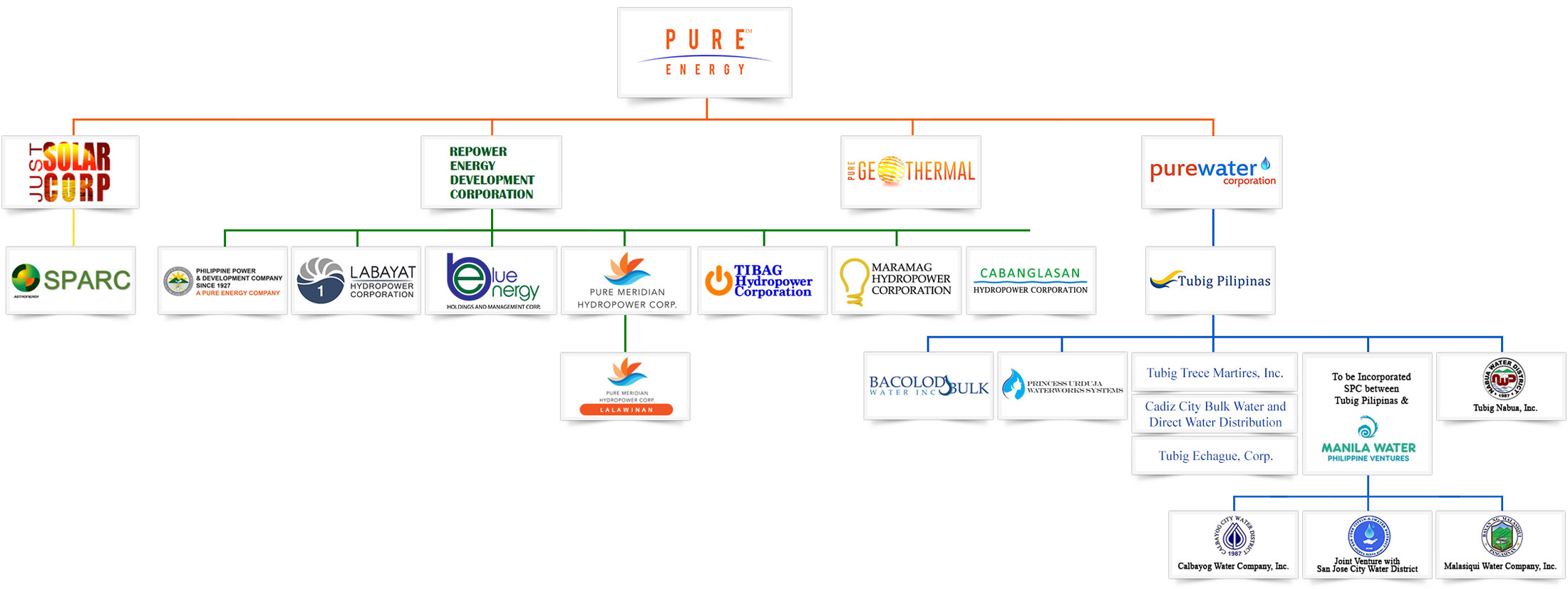
Just Solar Corporation
JUST SOLAR CORPORATION (JSC) was established to enter the solar energy business with or without the Feed in Tariff rate guaranteed by the Philippine Government. As levelized costs have fallen and grid parity is within reach, the company is rolling out its projects in niche areas where there is explosive growth potential that has not been tapped before.
Just Solar is reinventing the solar industry in the country by deploying its utility scale projects in embedded areas, whereby reducing transmission losses and empowering the Distribution Utilities through the introduction of high performance systems, streamlined operations, and focused engineering. The goal is to provide clean, sustainable and reliable peak solar energy at a reasonable cost for the benefit of the surrounding community and its allied industries.
Just Solar is growing through acquisition of strategically located solar farms of high potential, expanding the capacities of these farms according to demand needs of the host Distribution Utility and contestable customers in a particular area. It plans to further diversify its portfolio by entering the solar rooftop and floating solar market as well.
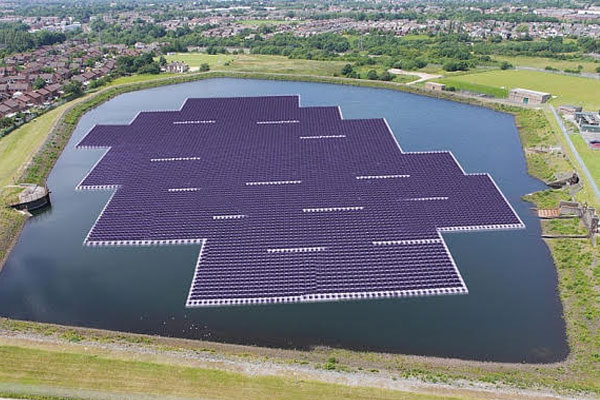
Repower Energy Development Corp.
Repower Energy Development Corporation (REDC) is a renewable energy developer of mini-hydropower projects through a "clustered approach method" where several projects are in a target area providing for shared economies of scale through common infrastructure, reducing the cost of development and improving the bottom line.
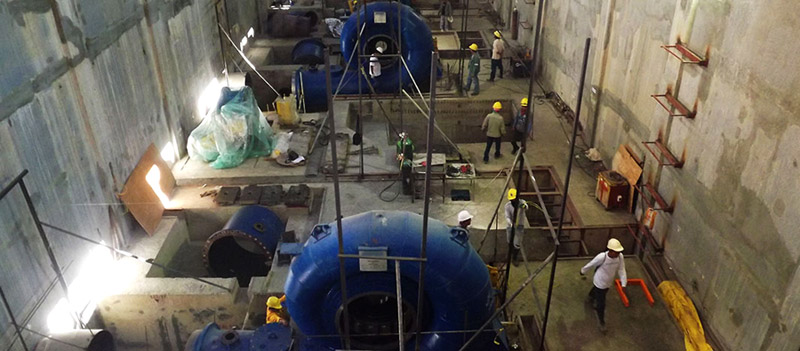
REDC has 124 MW of mini-hydropower projects clustered in Laguna, Quezon, Camarines Sur, Bukidnon, and other Provinces under development. This represents a USD500M investment in mini-hydropower development.
REDC plans to rapidly grow through strategic acquisition of existing hydropower plants, enhancing their value through operational improvements, focused redevelopment, and the introduction of the latest European technologies. It continues to search for other viable mini-hydropower projects, aiming to be a niche player in the renewable energy industry and to expand its footprint all over the country.
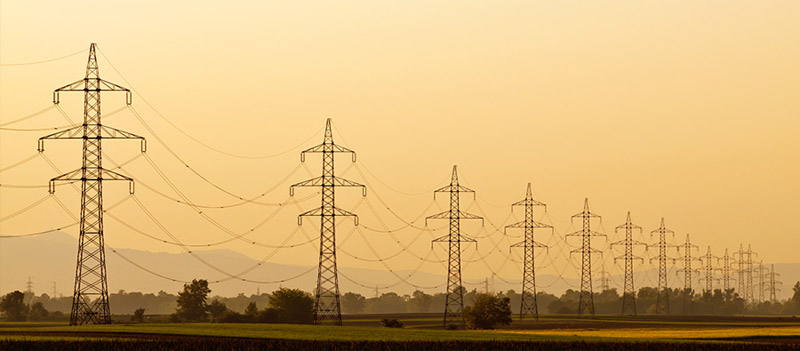
What is Hydropower?
Hydropower is a general short term for hydroelectric project. The basic principle of any hydroelectric project is that if water can be directed to flow from a higher level to a lower level, then the resulting water pressure by the water flow and gravity can be used to do work.
If the water pressure is allowed to move a mechanical component then that movement involves the conversion of the potential energy of the water into mechanical energy. Hydro turbines convert water pressure into mechanical shaft power, which can be used to drive a useful device such as an electric generator.

Typical Components of a Run-Of-The River Hydropower Installation
In order to produce the desired output of a run-of-the-river hydro installation, several components are required to efficiently control the river flow. These components are presented hereunder.

Advantages of Mini-Hydropower Projects
Storage plants which utilize dams have implementation problems related to social acceptability because in some cases, entire barangays will be submerged under water for the project. Hence, in the country, run-off-the-river plants are preferred and commonly found in most existing installations because of lesser social-related problems, foremost of which is the resistance of the people.
Enhances the forest cover of the watershed:
The Department of Energy (DOE) requires a watershed improvement plan in the final conclusion of the operations contract. Additionally, mini-hydropower developers are intrinsically incentivized to preserve the forest cover in order to maintain both water quality and quantity.
Saving in CO2 emissions on a Global scale:
Compared to a typical coal or gas power plant, a hydropower plant does not produce CO2 and prevents about 0.60 Kg of CO2 per KW-Hour of generation from entering the atmosphere, thus for One (1) Mega Watt Mini-hydro plant with an annual energy production of 4.4 Million KW-Hour at 50% Plant Factor, the emissions saved, were the energy to come from an equivalent fossil fuel-fed power plant is 4.4 M x 0.60 KG = 2.64 M KG or 2,640 Tons of CO2 per MW. This is equivalent to the annual CO2 emissions of 600 passenger cars.
Savings by the Philippine government from importation of oil:
In order to fuel typical gas power plants, the Philippine government imports X amounts of oil a year. A hydropower plant on the hand needs no oil to run and thus saves (0.30 liters of oil / kw-hr) x 4.4 million Kw-hrs. for 1 MW mini-hydro at 50% plant factor = 1.32 million liters of fossil based fuel will be saved or 8,300 barrels. Thus a hydropower plant saves the Philippine government about US$ 500,000 / year / MW worth of oil imports assuming price per barrel is at US$ 60.
Further, government directives under RA 9513 (Energy Act of 2008) provides numerous incentives related to run of river hydropower projects.
REDC SUBSIDIARY
REDC is a majority shareholder of Philippine Power and Development Company or PHILPODECO, one of the pioneers in the local Hydro Power industry. Established in 1927, PHILPODECO owns and operates three minihydro power plants in Laguna:
- Balugbog Mini-Hydro Power Plant in Nagcarlan, Laguna.
- Palakpakin Mini-Hydro Power Plant in San Pablo City and Calauan, Laguna.
- Calibato Mini-Hydro Power Plant in San Pablo City, Laguna.
Under REDC’s direction, PHILPODECO shall embark on a three-pronged comprehensive operational improvement program composed of equipment modernization, organizational restructuring, and enhanced financial management. It shall utilize the latest technologies to upgrade, expand, and automate its hydropower facilities. In addition, organizational restructuring activities will result in a leaner and more effective workforce that is most suitable for the changing times. Last but not the least, appropriate financial management methods will be implemented in line with corporate governance requirements.
At 88 years old and counting, PHILPODECO's mini-hydropower plants are historically the Philippines’ oldest operating plants. After improvements that will be introduced by REDC, we expect the three mini-hydropower plants will not only continue to operate but increase its present production for the next one hundred years to come - cementing a lasting legacy in the Philippine hydropower industry.
For other subsidiaries of REDC please refer to the organizational chart.
Pure Geothermal Inc.
Pure Geothermal Inc. (PGI) was organized with the prime objective of developing and operating purely brownfield geothermal energy projects to cater to the nation’s increasing demand for electrical power.
Why only brownfield projects?
This is mainly due to the astronomical risk involved in geothermal exploration activities, wherein the risk of failure is high. Geothermal exploration is similar to oil and gas exploration. It is a hit or miss thing where 1 in 10 or 20 drilling activities will likely result in a non-acidic positive well.
Advantages of Geothermal Energy and this Concession
- Geothermal energy is the only renewable energy resource that is baseload in nature, operating 24/7 comparable to coal fired power plants. This form of energy is not subject to weather conditions, time of day, seasonal changes, and the likes.
- O&M cost is minimal.
- The well site is only 20 kilometers to the NGCP 69 KV line.
- Previously 3 wells were drilled in this geothermal field. SL-1D was found to have the right temperature but due to the tightness of the surface, technology available then was not able to permeate steam through it. SL-2D in the meantime flowed steam and encountered positive upflowing fluids with temperatures reaching 280C at -1840m MSL. The third well did not hit the programmed target and consequently lower temperature was encountered.
PGI's Program of Activities in the Southern Leyte Geothermal Concession
- Revalidate the results of the 3G’s survey;
- Rehabilitate Well SL-2D;
- Drill a re-injection well;
- Install and commission an initial 5 MWe modular Geothermal Plant, and expanding it to 25 MWe in the short to medium term;
- Drill additional wells with the end view of developing and installing additional geothermal power plants up to the total size of the potential 110 MWe.
The geothermal field encompassing a 5,103-hectare area is sited within the Department of Energy's RE MAP Sheet 12-N-9. It is strategically located in the municipalities of San Juan, Anahawan and Hinundayan, all within the province of Southern Leyte.
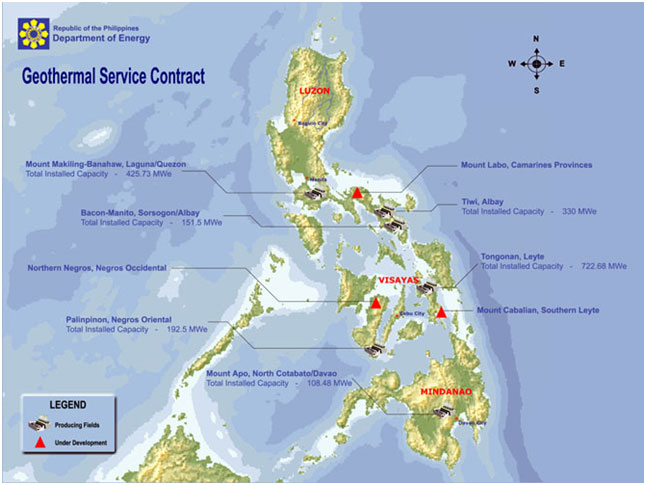
Map 1. Map of DOE Geothermal Service Contracts
EVALUATION UPDATE OF RESERVOIR POTENTIAL OF SOUTHERN LEYTE GEOTHERMAL PROJECT
The Southern Leyte Geothermal Project is located south of the renowned Tongonan Geothermal Field, towards the southern tip of the island of Leyte. Initial feasibility study conducted by the Japan External Trade Organization (JETRO) in 2001 – 2002 had estimated an available capacity of 110 MWe. Since then, an additional delineation well had been drilled and tested and reinterpretation of the geophysical survey were undertaken, providing new information on subsurface geology and reservoir characteristic of the geothermal resource. The updated study supports the previous findings of the initial study where a commercial size resource potential is present in the Southern Leyte Geothermal Project. High temperature (>260 C), neutral, high-chloride fluid is believed to be upflowing from the uplifted basement formation possibly heated by presence of magma chambers and intrusives (dikes) related to the volcanic activities in the area. Additional well drilling to delineate further the field are to be undertaken in the coming months.
1. INTRODUCTION
The Philippine Department of Energy’s (DOE) National Energy Plan for 2004-2013 included an additional 600 MWe contribution from geothermal energy, of which roughly 410 MWe is expected to be tapped within the Visayas, and of which the Southern Leyte Geothermal Project (SLGP) will be a contributor. Initial feasibility study conducted by the Japan External Trade Organization (JETRO) in 2001-2002 of the Southern Leyte Geothermal Project (Mt. Cabalian geothermal resource) has estimated an available capacity of 110 MWe (JETRO, 2002). This report was based on drilling and well test data from the first well in the area, SL-1D, and the geoscientific data available at that time. These included the reinterpretation of geophysical surveys, particularly the magneto-telluric surveys where new data from additional MT stations were obtained (Rigor, et al., 2001). At that time also, SL-1D was not discharged due to the poor permeability of the well.
The current study provides an update on the recent development at SLGP and a re-evaluation of the resource potential with the additional information gathered from the newly drilled well SL-2D, and the reinterpretation of the geophysical survey of the resource.
2. DRILLING UPDATE
With the updated interpretation of the geoscientific model of the Cabalian reservoir (Rigor, et al., 2001 and Layugan et.al, 2004), two additional wells were proposed to be drilled in 2003 to supplement the well information provided by SL-1D. However, only SL-2D was drilled in the first half of 2003, with the drilling of the third well (SL-3D) deferred pending the availability of the rig that was moved to the Tongonan geothermal field (Leyte Geothermal Production Field or LGPF) for production drilling.
SL-2D was drilled at Pad C situated at the northwest flank of Mt. Cabalian peak (Figure 1). The well was completed to 2493.7m measured depth (MD) (2362.3m vertical depth or VD) with a throw of 624.3m and azimuth of 354.5° (N 05.46° W) towards the western flank of Mt. Cantoyocdoc. Production casing shoe was set at 1547.7mMD with the slotted liner landed at the bottom of the well.
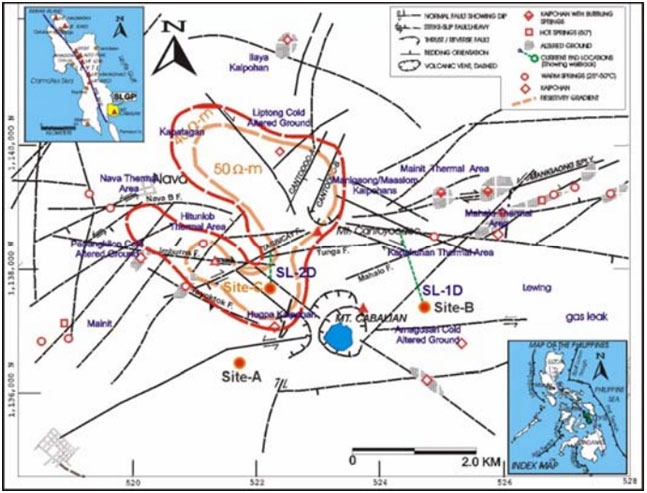
Figure 1: Location map of SL-2D showing initial geophysical boundary evaluated by Rigor, et. al. (2001)
Mineralogy encountered in SL-2D suggests higher temperatures than SL-1D. Estimated temperatures at the bottom of SL-2D range from 270° to 280°C, which was inferred to be masked by down flowing cooler fluids from the top zone. SL-1D mineralogy and actual/measured bottom temperature both show maximum temperature of only 240°C.
3. GEOLOGY UPDATE
Similar formations drilled through SL-1D were encountered in SL-2D, namely: Quaternary Volcanics (surface to 1085mVD) and the Tertiary Clastics (1085 to 2362mVD) (Zaide-Delfin, et al., 2003). In addition, hornblende dacite and microdiorite dikes intruded the Tertiary Clastics in SL-2D.
All four structural targets below the production casing shoe (based on the well design) were intersected by SL-2D. Geologic, petrologic and drilling data indicate good permeability for the intercepts of Imburna Splay, Tunga, Imburna and Tagbikay faults. An updated subsurface stratigraphy of the area with the two wells is shown in Figure 2.
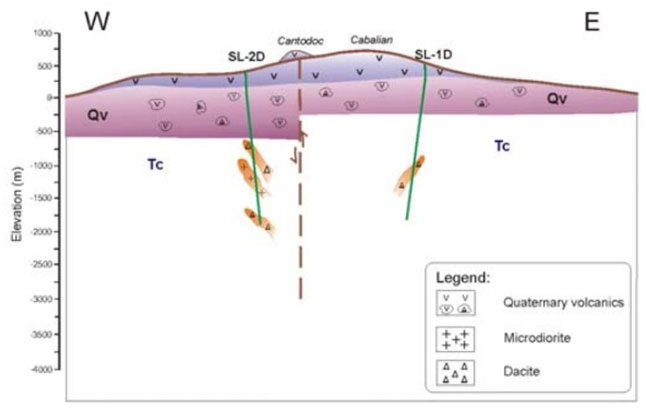
Figure 2: Stratigraphy of the Cabalian resource based on SL-1D and SL-2D.
4. GEOCHEMISTRY UPDATE
SL2D was discharged and tested at different wellhead pressure conditions from June 1 to July 31, 2003. The test ended when the well exhibited a steady drop in WHP with time until the flow finally collapsed.
Baseline chemistry discharge data from the well are generally stable at various wellhead pressures (from 0.45 to 0.11 MPaa) indicating the dominance of the shallow feed zone at 1800-2000mMD/1740-1920 mVD (i.e. the zone where Imburna fault was intersected) during the discharge. The chloride-enthalpy plot (Figure 3) indicate that SL2D’s reservoir was boiled from 250 to 190° C, and this boiled SL2D brine, with Cl of 6,000 mg/kg, was then diluted (and eventually cooled) as it manifested to the surface, represented by Mainit and Mahalo springs.
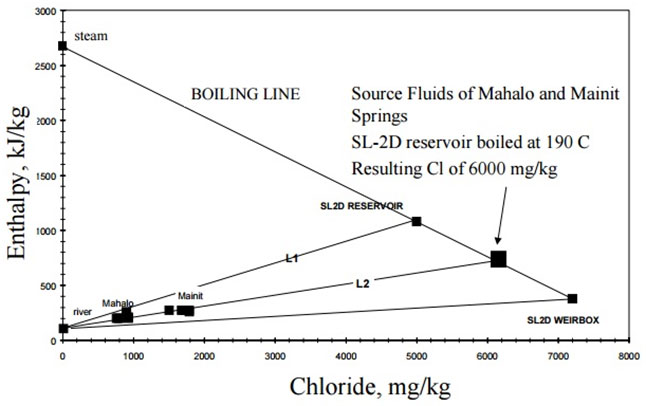
Figure 3: SL-2D chloride-enthalpy plot showing fluid source at about . 250°C
The assumption of single source of springs and well fluids is based on Cl/B ratio, which ranges from 28 to 31, similar to the Cl/B ratio of SL2D (30). The springs’ source temperature of 190°C is also well supported by silica mixing model. Sanchez (2003) estimated that the springs’ most likely source temperatures ranged from 180 to 205°C assuming maximum steam loss. SL2D data, therefore, suggest a narrower spring source fluid temperature of 190°C, at a Cl concentration of 6,000 mg/kg.
5. GEOPHYSICAL UPDATE
Layugan, et al. (2005) provided a re-interpretation of the resource boundary for the Southern Leyte Geothermal System based on the additional MT data obtained in 2000-2001 (Rigor, et al., 2001). Layugan, et.al (2005) inferred that the Cabalian system is most likely centered at the western flank of Mt. Cantoyocdoc as outlined by the uplifted resistive basement and represented by the mapped 40-100 ohm-m resistivity contour at –1500m elevation (Figure 4). From this uplifted resistive basement the outflows were drawn to coincide with the location of thermal manifestations. Outflow fluids to the east are channeled preferentially through the Mahalo Fault towards the Minit-Mahalo thermal area. On the other hand, geothermal fluid flows through the NW and EW trending faults (e.g. Nava, Imburna and Tayoktok Faults), which feeds the thermal springs to the west.
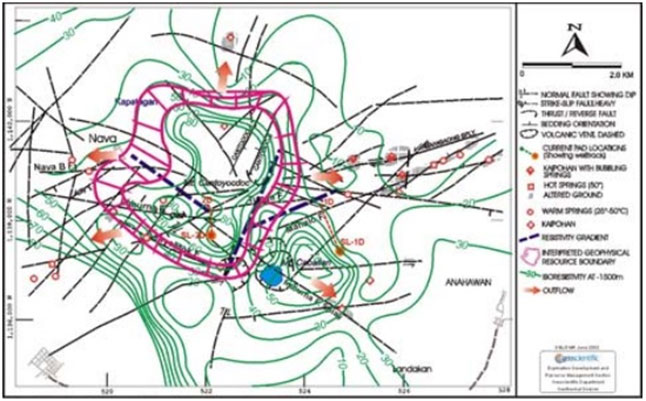
Figure 4: Iso-resistivity contour at –1500m RSL showing the geophysical boundary (from Layugan, 2005).
Minor outflows are also inferred towards the southeast and the north as indicated by similar trending faults and thermal manifestations within those areas.
6. WELL TEST UPDATE
Well SL-1D, despite having relatively high downhole temperatures, was found to be very tight and was no longer discharged. Computed transmissivity is only 0.16 d-m, and high positive wellhead pressures were monitored during the pumping tests.
SL-2D, on the other hand, underwent approximately 2 months discharge test. It flowed steam but was capped abruptly. This could be attributed to the well being severely damaged during drilling with about 14,700 bbls of mud lost in the open hole. The well is programmed to be acidized and retested, and expected to improve its output. Table 1 shows a summary of well information from SL-2D. Shut and flowing downhole temperature and pressure profile of the well are shown in Figure 5.
6. 1 PREDICTED SL-2D OUTPUT
The likely output of SL-2D is estimated based on the initial discharge characteristics and assuming the formation damage will be removed after acidizing. This means that the low productivity index of 2.3 kg/s-MPa will improve and attain an equivalent value approaching the injectivity index of about 9 kg/s-MPa. Evaluation of productivity indices and injectivity indices of PNOC-EDC wells, indicate approximately a one-to-one correlation.
Wellbore simulation runs indicate that at 2.3 kg/s-MPa, a likely pressure drawdown of about 6.5 MPa will occur to attain a commercial wellhead pressure of about 0.7 MPa. The massflow and enthalpy at this WHP are about 16 kg/s and 1100 kJ/kg, respectively. With acidizing, the massflow is expected to increase to about 59 kg/s. Assuming the same enthalpy range, the output of the well is estimated to reach about 4.5 MWe (at an assumed 0.7 MPaa separation pressure and 2.5 kg/s-MWe steam rate).
Higher output may be attained if the fluid enthalpy will be higher, i.e. two-phase discharge or contribution from the hotter brine (270-280 deg C) at depth dominates the flow.
Table 1: SL-2D well data and output information.
7. CONCEPTUAL MODEL
The inferred heat source is located within the geophysical boundary defined by the updated geophysical survey, where the heat source is attributed to the presence of possible magma chambers and shallow intrusives related to the volcanic activities of Mt. Cabalian and Mt. Cantayocdoc. High-chloride, high temperature (260 deg C or higher) fluids upflow from the uplifted resistive basement formation (represented by the 40-100 ohm-m resistivity contour at –1500m), and outflows towards the east and west through major geologic faults. Minor outflows to the southeast and north as evidenced by the presence of thermal manifestations in both areas, may be attributed to similar trending faults which could channel the fluid.
The mineral assemblages found in both SL-1D and SL-2D suggest occurrence of neutral-pH fluid in the reservoir. However, high non-condensable gas (mainly CO2) may be expected in the reservoir with the presence of carbonaterich rocks in the formation. Mineral deposition in the well may be expected with the high calcite silica index obtained from the discharge fluids of SL-2D.
8. RESERVE ESTIMATEM
Stored heat calculations, based on preliminary geoscientific surveys and downhole information from the two drilled wells in the area, were conducted to determine the estimated reserve capacity of the Mt. Cabalian resource in the Southern Leyte Geothermal Project.
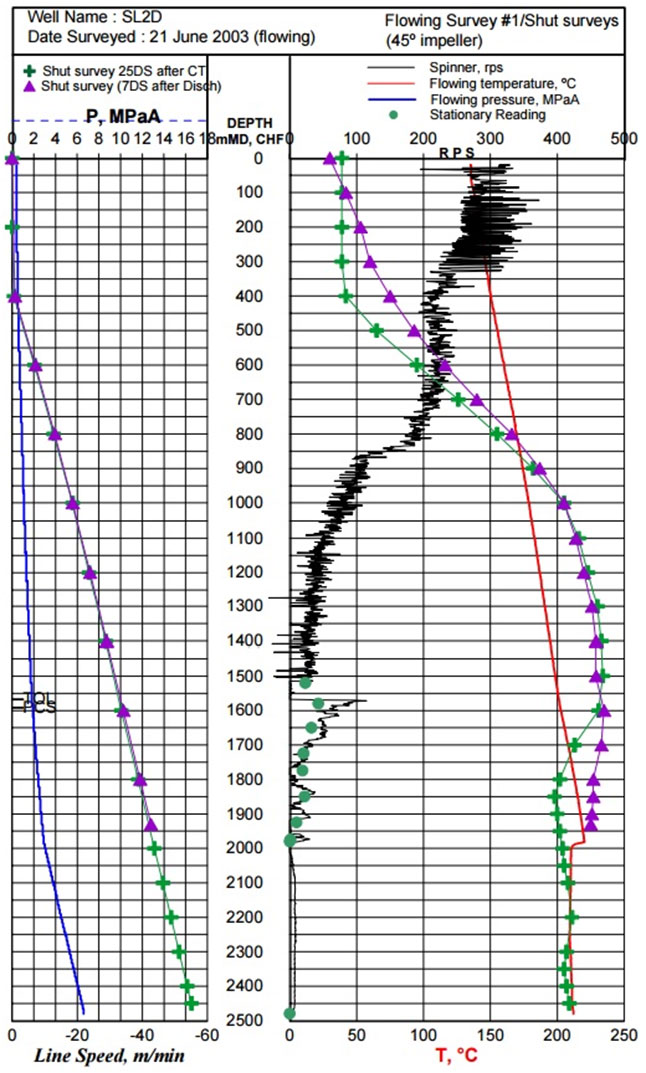
Figure 5: SL-2D downhole temperature and pressure profile.
8.1 RESOURCE AREA
Magneto-telluric surveys evaluated by Layugan, et al. (2005) showed a resource area of about 7.5-12 sq.km. representing the inner and outer boundaries, respectively (as shown in Figure 4). Well SL-1D is located outside the resource block, which would tend to confirm the low permeability encountered in the well. SL-2D is found within the resource boundary.
8.2 RESOURCE TEMPERATURE
A cross sectional plot of the MT survey with the two drilled wells is shown in Figure 6 indicating also the estimated downhole temperatures in the wells based on analysis of petrological. A maximum temperature of about 270-280 deg C is estimated at the bottom of SL-2D while the highest temperature at SL-1D is about 240 deg C. Maximum measured downhole temperature at SL-1D closely matches the petrology data. On the other hand, downhole temperature data of SL-2D appear to be masked by cooler fluid downflowing from shallower depth (1600mMD). So far the highest temperature recorded in SL-2D is only 235 deg C at 1600mMD (near the production casing shoe).
The average reservoir temperature is estimated to be about 260 deg C, based on the temperature distribution from about –1000m MSL (where the 220 deg C temperature is expected) and the bottom temperatures expected in SL-2D and SL-1D. The 220 deg C limit is the temperature at which, based on PNOC-EDC experience, the fluid will flow to the surface, particularly for liquid reservoirs.
Figure 6: Cross section of the MT interpretation showing also the estimated downhole temperatures based on petrology and actual temperature data.
8.3 RESOURCE VOLUME
The thickness of the reservoir is bounded by the 220 deg C isotherm as the upper bound of the reservoir (approximately at around –1000m MSL), and the –2500m MSL depth as the lower bound. The –2500mMSL is obtained by taking the average depth of SL-1D and SL-2D, and adding an additional 500m. to account for the additional heat that can be extracted from the rock by the fluid sweeping through the reservoir at depth. The computed thickness of the reservoir is therefore about 1500m.
8.4 POROSITY AND RECOVERY FACTOR
These parameters characterize the reservoir permeability, and how much fluid in-place within the reservoir can be extracted for power generation. For the stored heat calculations, we assumed a porosity of about 8%, which is typical for geothermal reservoirs developed by PNOCEDC. The corresponding recovery factor, which is a function of porosity, is about 20% (Nathenson, 1975).
8.5 CONVERSION EFFICIENCY
Bodvarsson (1974) and Nathenson (1975) evaluated the conversion efficiency of geothermal reservoirs from heat to electrical power as a function of temperature. At the estimated average reservoir temperature of 260 deg C, the conversion efficiency is estimated at 12%.
8.6 PLANT LIFE AND LOAD FACTOR
The expected plant life is about 25 years with an assumed load factor of about 92% equivalent to one-month PMS per year.
8.7 STORED HEAT CALCUATIONS
Based on the above parameters and using straightforward calculations of the stored heat, the estimated reserve capacity that can be tapped for power generation is about 2132 MWe-years or about 85 MWe for 25 years.
A Monte Carlo analysis of the reserve estimate calculation was undertaken due to the uncertainties in the values assumed for each parameter in the stored heat calculations. Through this method, probability distributions were assigned to each parameter in the stored heat calculation that can affect the outcome of the calculations.
Monte Carlo simulation results indicate a mean capacity of 90 MWe for the Cabalian resource block.
9. SUMMARY AND CONCLUSION
The study supports the previous conclusion of the JETRO study in 2002 where a commercial size resource potential is present in the Southern Leyte Geothermal Project. Other findings in this study are:
- High-temperature (>260 deg C), neutral, high-chloride fluid is believed to be upflowing from within the resistive uplifted basement formation within the area enclosed by the 40-100 ohm-m block where the heat source is attributed to the possible presence of magma chambers and intrusives (dikes) related to the volcanic activities of Mt. Cabalian and Mt. Cantayocdoc. Outflows towards the east and west are dictated by fluid structures and supported by the presence of thermal manifestations (e.g. springs, kaipohans and altered grounds) in these areas. Minor outflows are also noted to the north and southeast that are also potential resource sites.
- The inferred reservoir block of about 7.5 to 12 sq.km. has a resource potential of about 85-90 MWe based on stored heat calculations and Monte Carlo simulation. The resource also has a 20% probability of attaining 130 MWe.
- Based on the expected output of SL-2D after acidizing, the likely average output of the wells in SLGP is about 4.5 MWe. Fluid chemistry of the well as well as the presence of calcite-rich rocks in the formation indicate possible occurrence of mineral deposition in the discharge.
- A more detailed monitoring of the SL-2D discharge should be conducted after the well is acidized. With the removal of the large volume of drilling mud deposited in the well, the higher output predicted in the well can be confirmed. In addition, the fluid temperatures at depth (particularly at the bottom where temperatures believe to range from 270 to 280 deg C based on petrology) will also be validated. The fluid chemistry of the well will be fully assessed for its potentials with regards to NCG and possible mineral deposition, particularly calcite.
- Additional well drilling should be targeted towards the west and further north to delineate and validate the resource boundary defined by the geophysical (MT) survey.
- A more detailed feasibility study can be conducted once the results of SL-2D acidizing and retest, and information from the additional exploration drilling are available.
Source: Evaluation Update of Reservoir Potential of Southern Leyte Geothermal Project Philippines, (2005), Francis X.M, Sta. Ana, Domingo B., et. al. Proceedings World Geothermal Congress, Antalya, Turkey. PNOC- Energy Development Corporation, Merritt Road, Fort Bonifacio, Makati City.
Pure Water Corporation

Pure Water Corporation (PWC), through its subsidiary, Tubig Pilipinas Group, Inc. (TPGI) is a complete bulk water supply and distribution company. TPGI currently provides bulk water supply and water Distribution to niche village housing projects located in Trece Martires, Gen. Trias, and Tanza in Cavite, and Cadiz City in Negros Occidental.
Bacolod Bulk Water Inc. (BBWI), a subsidiary of TPGI, inaugurated its first phase water treatment plant in October 2017, and supplies the Bacolod City Water District with an initial 15,000 cubic meters per day of potable water. It is currently constructing another pipeline that will bring water from the town of Murcia to Bacolod City for the second phase of the bulk water project. By the end of the first quarter of 2018, BBWI will increase supply to 30,000 cubic meters per day to Bacolod City. The volume is set to escalate up to 150,000 cubic meters per day of potable water.
Princess Urduja Waterworks Systems Inc (PUWSI), a company that was formed in January 2012 that holds the exclusive franchise to supply, operate and maintain water utility systems in its home base in Sual, Pangasinan. It presently is supplying and distributing potable water to the towns of Sual and Labrador. It is expanding its coverage area and increasing its service connections within these 2 municipalities. PUWSI is a subsidiary of TPGI.
MANILA WATER - TUBIG PILIPINAS JOINT PARTNERSHIP AGREEMENT, over the course of 2017 Manila Water and TPGI have signed numerous joint venture agreements to develop water projects in different cities and towns around the country.
Pure Water Corp. is in negotiation with different stakeholders and LGUs to expand its footprint nationwide, not only on bulk water supply and distribution but also in waste water treatment.
Locations
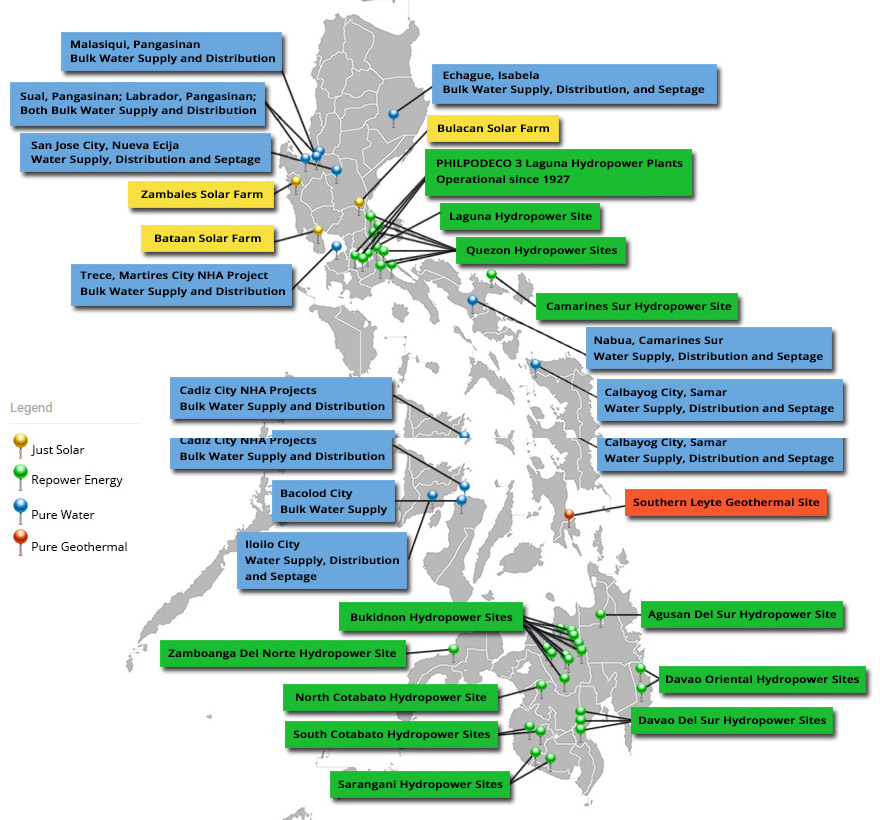
Partners
Meralco
Founded and organized in 1891, the then La Electricista was the first company to provide electricity to the Philippines. Since then, MERALCO has maintained its prominence. It is Philippines’ largest distributor of electrical power. It is metro Manila’s only electric power distributor and holds the power distribution franchise for 22 cities and 89 municipalities including the whole of the NCR as well as the provinces of Bulacan, Cavite, Rizal, Batangas, Laguna and Quezon. MERALCO (PSE:MER and MERB) is listed in the Philippine Stock exchange and is part of the exchange index (PSEi). Meralco has partnered with Repower to build a portfolio of mini hydropower plants throughout the country.
Frabelle Fishing Corporation
The Frabelle Fishing Corporation is a fully integrated seafood company and has been in the fishing industry for over 50 years. Frabelle is the one of the largest fishing companies in the world, number one in the world when it comes to fleet size, and number three in terms of volume of tuna. Its subsidiary, Frabelle Foods Corporation is a major player in the South East Asian food industry, it operates a cannery in Papua new Guinea and owns fish and meat processing plants around the country that provide a wide range of fresh and processed foods under their brand name Frabelle Foods. The Frabelle Group has ventured into the renewable energy business lately, and aside from their own project, they have partnered with Repower to build a mini hydropower plant in Quezon Province.
Manila Water Company
Manila Water Company provides water treatment, water distribution, sewerage and sanitation services to more than six (6) million people in the eastern side of Metro Manila, comprising a broad range of residential, commercial and industrial customers. The Manila Concession encompasses twenty three (23) cities and municipalities spanning a 1,400-square kilometer area that includes Makati, Mandaluyong, Pasig, Pateros, San Juan, Taguig, Marikina, most parts of Quezon City, portions of Manila, as well as the following towns of Rizal: Angono, Antipolo, Baras, Binangonan, Cainta, Cardona, Jala-Jala, Morong, Pililia, Rodriguez, San Mateo, Tanay, Taytay, and Teresa.
TGV Builders Inc.
TGV BUILDERS, INC. was established in 2000 by Simplicio C. Belisario, the company started as a general engineering and water supply company. Since then it has completed the construction of numerous bulk water supply systems, direct distribution water systems, wells, and water pipe laying projects. Today TGV is an all around water supply construction, operation, and management company. It owns, supplies bulk water, operates and maintains the water supply and distribution systems of Calasiao, Sual, and Labrador towns in Pangasinan. It also provides Bulk water supply to the Metro Midsayap Water District, Marilao Water District, Bulacan Water District, and Metro Cotabato Water District.
Media
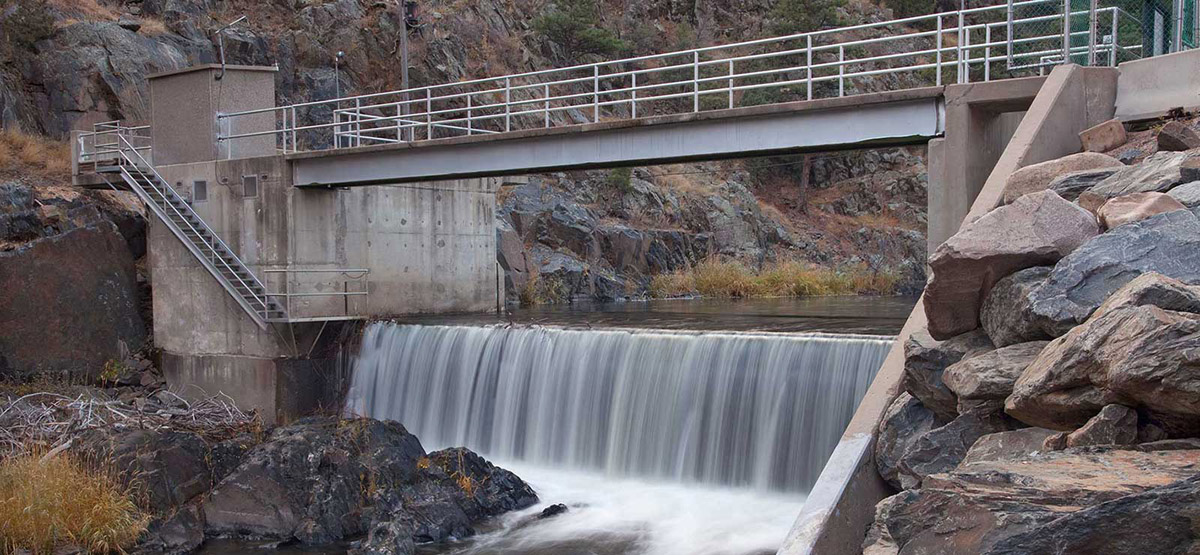
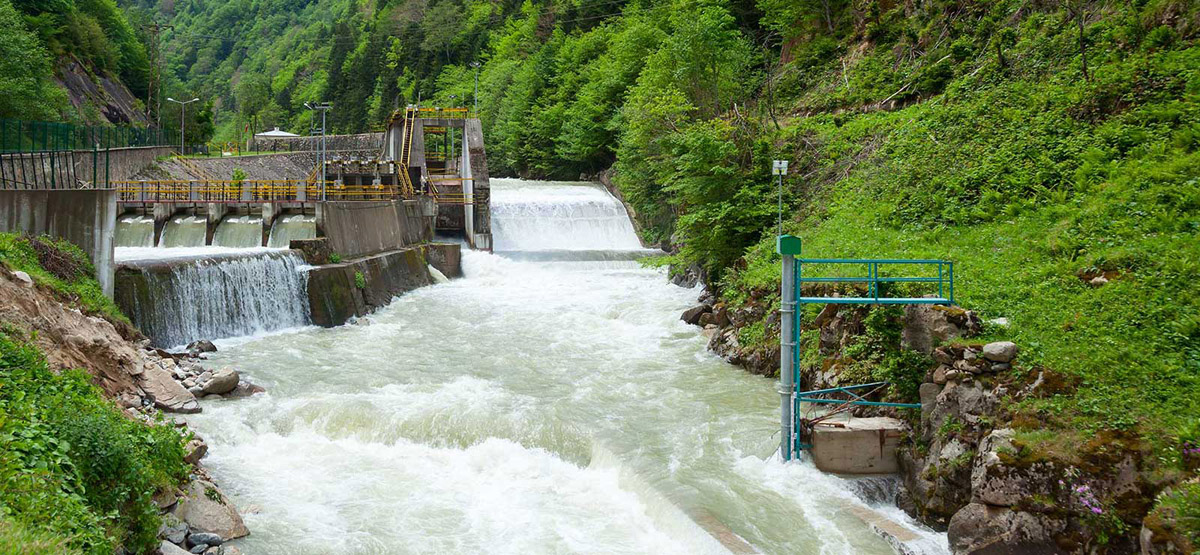
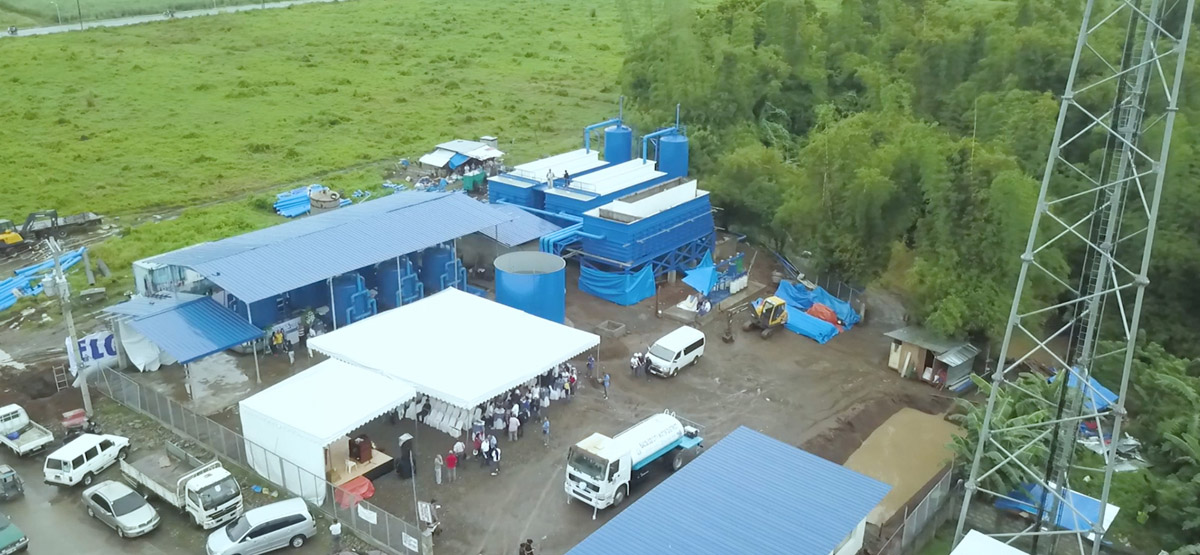
Contact Us
Pure Energy Holdings Corporation
Address: 3/F JTKC Centre, 2155 Don Chino Roces Ave., Makati City 1231
Phone: +63 2 813 8892 to 97
Fax: +63 2 810 3536
E-mail: contact@pureenergy.com.ph
Find us on Google Maps
sponsored links
SIMILAR COMPANIES/PRODUCTS/SERVICES
Terms of Use/Privacy Policy Advertise Buy me coffee
